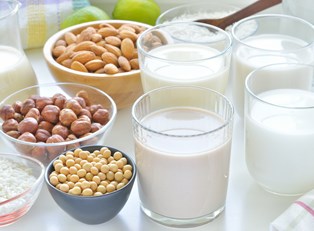Lactose intolerance is the unfortunate inability of the body to properly digest dairy products. “Lactose” is the sugar in these items and the part of dairy the body responds so poorly to. The small intestine doesn’t have enough lactase, an enzyme that breaks down lactose, and so the lactose upsets the gastrointestinal tract. Half to three quarters of the world’s population is lactose intolerant, a number increased by the fact that the condition is hereditary.
Lactose Intolerance Causes
The most common form of lactose intolerance develops with age. While you may have had no difficulty with milk products as a small child, as you get into your teenage and young adult years, you may find more and more that dairy items disagree with you. This often happens naturally, because our bodies work less efficiently with age and so produce less lactase. It is possible for the condition to correct itself when it develops suddenly, but symptoms can also get worse as time goes on or at very specific times, such as during high stress.
Very occasionally, babies are born with lactose intolerance; these infants gain weight less quickly than other babies, have foamy or soft stools, vomit and develop diaper rash more frequently, and may be more irritable than normal babies.
Lactose Intolerance Symptoms
Not everyone with lactose intolerance responds exactly the same to foods with lactose in them. While it could take a very large amount of lactose a long time to cause any symptoms, others may find their bodies revolting very quickly to a very small amount. Furthermore, while some people may respond badly to some foods with lactose in them, other dairy foods may digest just fine for them.
For example, while drinking a glass of milk may cause a person to become extremely sick, the same person might be able to eat a bowl of ice cream with no problems. Generally, the body responds within about one half to two hours. Symptoms include bloating, stomach cramps, gas, diarrhea, nausea, and vomiting.
Lactose Intolerance Trigger Foods
While any dairy product, from milk and cheese to yogurt and ice cream, can cause these symptoms in some people, there are other, less common foods and products that have small amounts of lactose in them as well. For example, baked goods often use milk or milk varieties (powdered milk or condensed milk). Despite such a small concentration of dairy, some people can still develop problems from these items. Additionally, some pills, such as birth control and over the counter antacids have lactose in their composition.
Lactose Intolerance Treatment
There is no cure for lactose intolerance, but there are a wide variety of medicines available to help those who suffer from it be able to eat dairy in peace. Taking a dairy digestive supplement a few hours before you eat can help you avoid the symptoms you generally associate with a nice bowl of ice cream. Additionally, there are more and more varieties of dairy products that have a lactose-free option. Items like soy milk and frozen yogurt are often good alternatives to dairy products.
Lactose Intolerance Dangers
Lactose intolerance may not seem like a severe issue in and of itself, but it can lead to serious problems. As mentioned above, infants with lactose intolerance may not get all the nutrients they require, leading to malnutrition. This can happen to adults as well, who may not get the calcium their body requires, leading to issues like osteoporosis in old age or tooth decay from lack of bone and tooth development. Dairy products are also a significant source of Vitamin D, a lack of which can result in weaker bones and deformities of the skeletal system. It is essential to take vitamins or eat foods that replace those vitamins and nutrients found only in dairy products for the lactose intolerant person.




